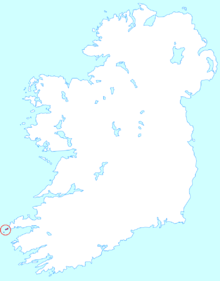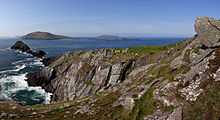Blasket Islands



The Blasket Islands (Na Blascaodaí in Irish - etymology uncertain: it may come from the Norse word "brasker", meaning "a dangerous place") are a group of islands off the west coast of Ireland, forming part of County Kerry. They were inhabited until 1953 by a completely Irish-speaking population, and today are part of the Gaeltacht. The inhabitants were evacuated to the mainland on 17 November 1953.[1] Many of the descendants currently live in Springfield, Massachusetts, and some former residents still live on the Dingle Peninsula, within sight of their former home.
The islanders were the subject of much anthropological and linguistic study around the end of the 19th and beginning of the 20th centuries particularly from writers and linguists such as Robin Flower, George Derwent Thomson and Kenneth H. Jackson. Thanks to their encouragement and that of others, a number of books were written by islanders that record much of the islands' traditions and way of life. These include An tOileánach (The Islandman) by Tomás Ó Criomhthain, Peig by Peig Sayers and Fiche Blian ag Fás (Twenty Years A-Growing) by Muiris Ó Súilleabháin.
The Blasket Islands have been called Next Parish America, a term popular in the United States and recalled in the book The Blasket Islands - Next Parish America by Joan and Ray Stagles.[1]
The six principal islands of the Blaskets are:
- Great Blasket Island (An Blascaod Mór)
- Beginish (Beiginis)
- Inishnabro (Inis na Bró)
- Inishvickillane (Inis Mhic Uileáin)
- Inishtooskert (Inis Tuaisceart)
- Tearaght Island (An Tiaracht)

References
External links
| Wikimedia Commons has media related to Blasket Islands. |
| |||||||||||
Coordinates: 52°05′21″N 10°32′49″W / 52.08917°N 10.54694°W